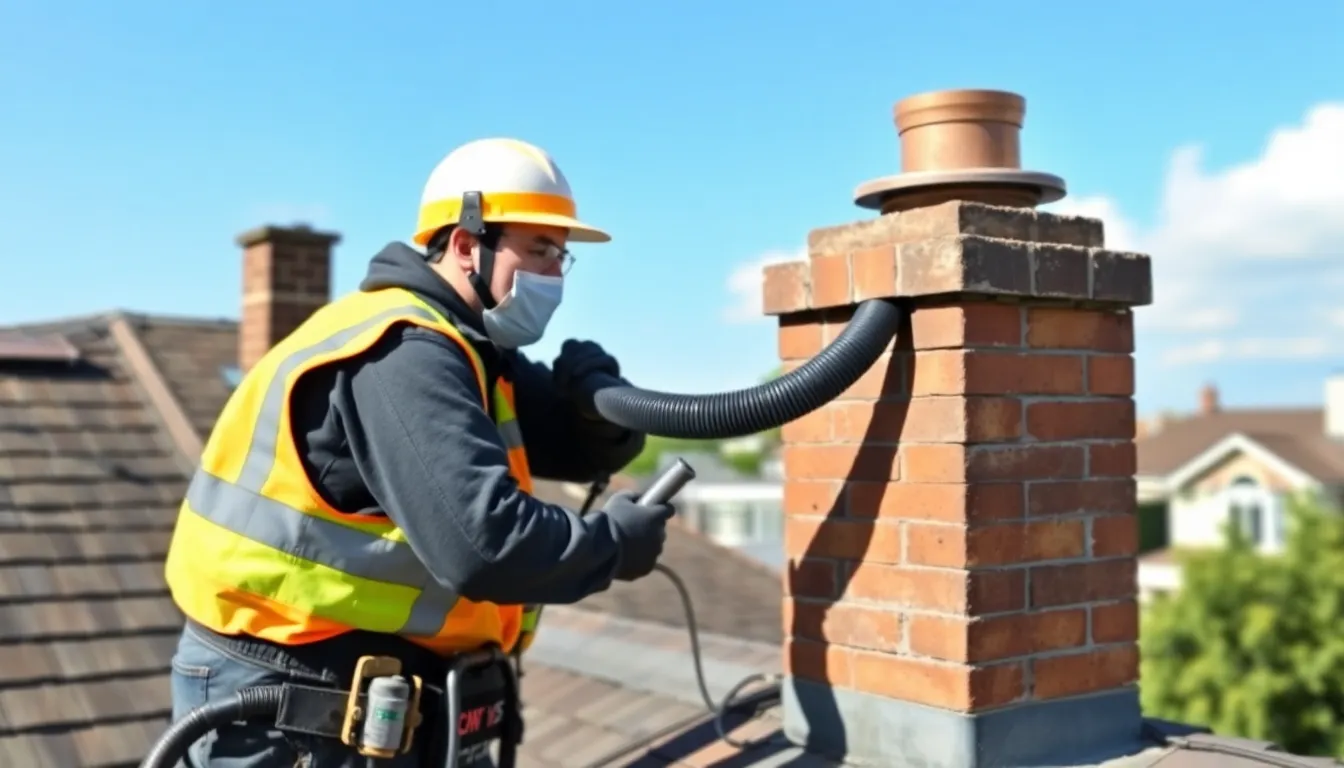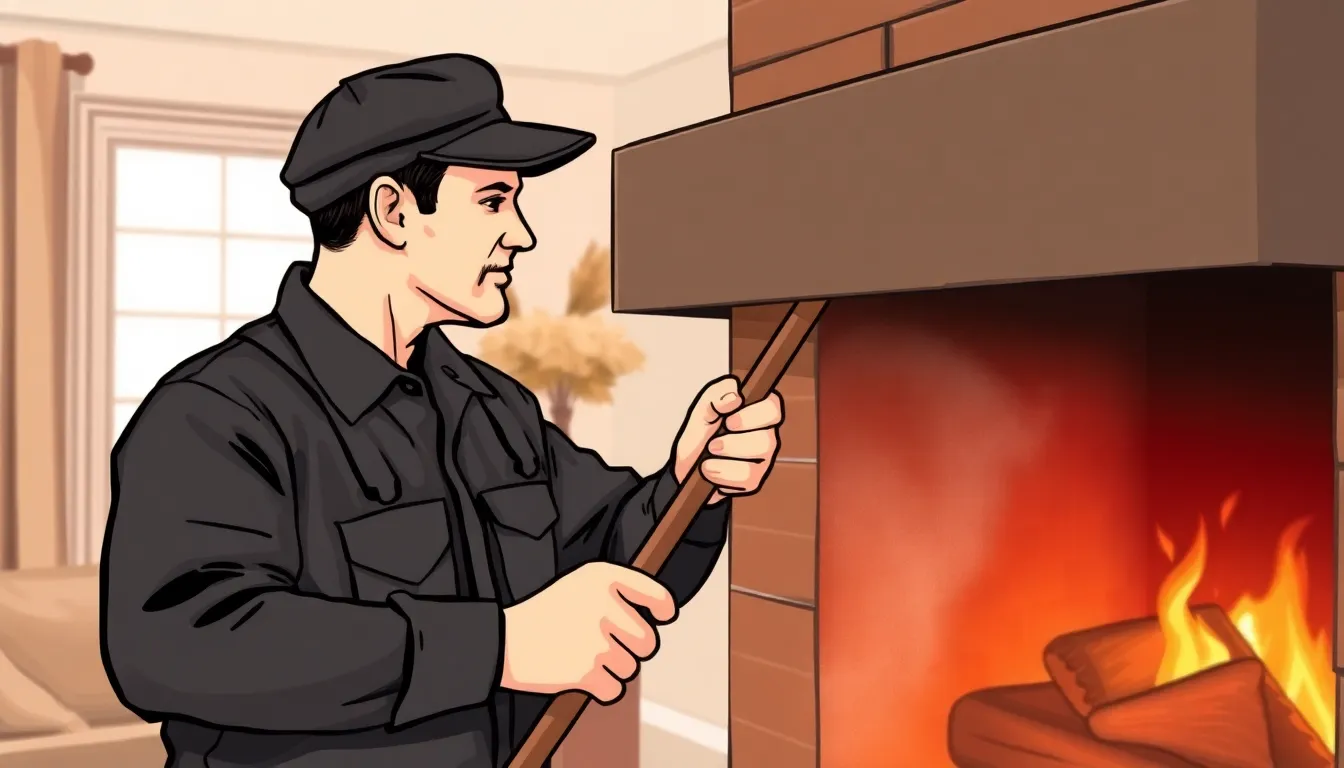When was the last time a chimney sweep visited your home? If it’s been a while, you might be flirting with disaster—or worse, an unwanted visit from Santa Claus who’s had one too many cookies! Keeping your chimney clean isn’t just about avoiding soot-covered stockings; it’s essential for safety and efficiency.
Table of Contents
ToggleOverview of Chimney Sweeping
Chimney sweeping involves cleaning and inspecting chimneys to ensure safe operation. Regular maintenance guards against fire hazards and enhances efficiency.
Historical Background
Chimney sweeping dates back to ancient civilizations, with evidence from Roman times. Sweeps used tools made from broom-like brushes to clear soot. In the 18th century, throughout Europe, chimney sweeps became commonplace, employing young children due to their size. The profession gained notoriety, leading to regulations aimed at protecting workers. By the 19th century, sweeping methods improved with the introduction of mechanical equipment. These advancements increased efficiency, establishing sweeping as an essential practice for chimney care.
Importance of Chimney Sweeping
Chimney sweeping reduces the risk of house fires caused by creosote buildup. Creosote, a flammable substance, accumulates from burning wood or coal. This maintenance task also prevents harmful gas exposure, including carbon monoxide. Regular sweeping promotes optimal airflow, ensuring heating systems operate efficiently. Homeowners benefit from improved energy use and comfort. Many communities recommend annual inspections, especially for active fireplaces or wood stoves. Keeping chimneys clean enhances safety and extends the lifespan of heating systems.
Types of Chimney Sweeps

Chimney sweeps use various methods to maintain and clean chimneys effectively. Understanding these methods highlights the evolution of chimney care over time.
Traditional Chimney Sweep Methods
Traditional brick-and-mortar techniques involved manual tools. Sweepers often utilized brushes affixed to long rods, enabling them to scrub creosote and soot from chimney walls. Young apprentices frequently assisted seasoned sweeps during labor-intensive jobs, learning the trade through hands-on experience. Open fires and wood stoves were prevalent in homes, making regular sweeping crucial to prevent dangerous build-ups. The sweeping process often involved climbing onto roofs and using ladders, requiring physical strength and agility.
Modern Chimney Sweep Techniques
Modern chimney sweeps employ innovative tools and technologies. Vacuum systems enhance efficiency by capturing soot and debris, minimizing mess during the cleaning process. Thermal imaging cameras enable technicians to detect blockages and structural issues within chimneys. Chemical treatments aid in breaking down stubborn creosote, ensuring a thorough clean. Drones can also access hard-to-reach areas, providing a safer alternative for inspections. These advancements position modern chimney sweeps as vital for maintaining safety standards and improving heating system efficiency.
Benefits of Regular Chimney Sweeping
Regular chimney sweeping provides significant advantages by ensuring safety and maintaining the efficiency of heating systems. Homeowners benefit immensely from the routine cleaning and inspection of chimneys to prevent hazards.
Safety Considerations
Safety remains a top priority with regular chimney maintenance. Accumulated creosote poses a serious fire hazard, increasing the risk of chimney fires significantly. Proper sweeping reduces this risk, protecting not only the home but also its occupants. Carbon monoxide buildup represents another danger; it can go undetected if chimneys are not cleared, posing health risks to residents. Inspecting chimneys helps identify cracks or blockages that could lead to dangerous gas intrusion. Annual chimney inspections support a safe living environment, giving peace of mind to homeowners.
Maintenance of Heating Efficiency
Chimney sweeping enhances heating efficiency, allowing for optimal airflow. Restricted airflow from soot and creosote buildup leads to reduced heating system effectiveness, forcing appliances to work harder. This inefficiency ultimately raises energy bills and can shorten equipment lifespan. Routine cleaning ensures that fireplaces and stoves operate efficiently, improving heat distribution in the home. Proper maintenance also aids in preserving the structural integrity of the chimney itself, contributing to long-lasting home heating solutions. Regular care translates to enhanced performance, saving money in energy costs.
Choosing a Chimney Sweep Service
Selecting the right chimney sweep service is crucial for maintaining safety and efficiency. Homeowners benefit from understanding key factors before hiring.
Credentials and Certifications
Reputable chimney sweeps often possess certifications from professional organizations such as the Chimney Safety Institute of America (CSIA) and the National Chimney Sweep Guild (NCSG). These certifications demonstrate a commitment to industry standards and ongoing education. Additionally, licensing requirements vary by state, so checking local regulations ensures compliance. Experienced professionals tend to have relevant training in safety practices, inspection techniques, and cleaning methods. Asking for proof of insurance protects homeowners from liability during the service.
What to Expect During a Sweep
During a chimney sweep, homeowners can expect an initial inspection to identify issues like creosote buildup or structural damage. The sweep typically utilizes specialized tools, such as brushes and vacuum systems, to remove debris and soot effectively. Besides cleaning, the technician checks for blockages and ensures proper airflow. Homeowners might also receive recommendations for maintenance and repairs if necessary. Following the service, they should obtain a detailed report outlining the findings and any required actions for their chimney’s health.
Regular chimney sweeping is essential for maintaining a safe and efficient home. By prioritizing this task, homeowners can significantly reduce the risk of fire hazards and ensure proper airflow in their heating systems. The evolution of chimney care methods underscores the importance of staying updated with modern practices. Choosing a reputable chimney sweep service with the right credentials can make all the difference in achieving optimal results. With a commitment to regular maintenance, homeowners can enjoy peace of mind, knowing their chimneys are in good condition and their homes are safe.



